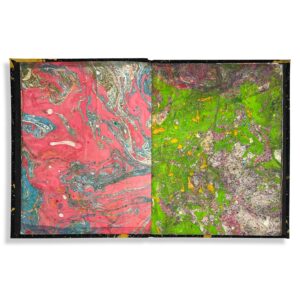4000 (planes shot down)
4000 (planes shot down)
Date
2017
Edition Size
unique
Media
Monoprint, Oil paint, Sumi Ink, tsunaminagashi
Paper
Rice paper
Dimensions
13 × 9.5 in
Location
Queens, NY
Collection
Collection Development, Print Portfolios$ 4,800.00
Unavailable
View Collectors
Harvard University, Houghton Library
4000 (planes shot down): a tsunaminagashi Vietnamese propaganda print portfolio is a series of monoprints on found Vietnamese War Communist propaganda posters that the artist has collected during trips to visit his motherland. Using his tsunaminagashi marbling technique in pools of water, these colorful collaborations distort the original stark war imagery and bring out their aesthetic beauty, channeling psychedelic show posters as much as agitprop. The process of printing involves laying the posters into water, which blurs the original poster’s inks, unsettling the pigment from the past and commenting on our often faulty collective memory. 4000 (the number of US airplanes shot down during the war) is both the artist’s research into a war that tore his family apart and a way to activate the visual imagery used to promote the country’s unity.
Curator’s note:
“In this beautiful set of manipulated prints, sTo Len dances around and through provocative, intimate, and historical issues with draping beautiful, fluid, glowing gowns of color. sTo’s tsunaminagashi interventions soften the harshness of this wartime anti-American propaganda, blurs it into almost nostalgic reminiscence, and yet also reintroduces the very real and continuing legacy of the brutality of the USA’s military invasion of Vietnam and the building of the racist anti-Asian “Red Scare” propaganda movement of the US government and American corporations in the 20th Century.
Less than two decades after dropping two atomic bombs on a surrendering Japan, the USA initiated a brutal bombing and chemical weapons campaign that killed millions in Vietnam, Laos, and Cambodia. Much like the Nazis, the USA normalized the torture and extra-judicial killing of hundreds of thousands of Vietnamese soldiers and civilians in an immense scorched earth policy, that continues to have environmental and health repercussions up to this day.
I can’t help but think about the intersectionality of the current wave of violence against Asian people in the USA in relation to the decades of anti-Vietnamese and “Red” Chinese propaganda that I (and most people in the USA) grew up with in the 1960s. It’s just shocking how this unfortunate, yet inevitable, trajectory was allowed, no, was encouraged, by corporate and state forces, to transpire. While I find these prints gorgeous and hilarious, they are also disturbing and they activate a lot of childhood feelings and memories in me, and I’m sure, in many other people in the USA and Vietnam.
There’s something unresolved/unacknowledged about the Atomic Bombing of Japan and the USA/UK losing its wars against China, North Korea, and Vietnam that feeds a lot of hate and racism in this country. It’s almost as if anti-Asian racism is in itself a form of revenge for the USA military atrocities (which equal ethical defeats) and actual military defeats. These historical issues have just started to be addressed in this country, but in general, ignorance is hate’s greatest ally, and ignorance is persistent in the USA.
As he is doing with his multi-media work as the artist in residence at the New York City Department of Sanitation, sTo is not shying away from doing the dirty work, from the discarded, the heavy, the ruin, the refuse of both our environment and history. Rather he is embracing the complexity by re-framing it in his aesthetic which is both beautiful and perceptive, and giving it back to those of us, all of us, who thought we could just throw it away and make it disappear. sTo Len gives us back our history (and our garbage) in a way that makes us reconsider it. He is constantly working against ignorance.” – Marshall Weber

















